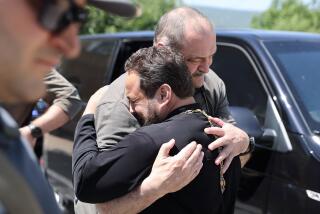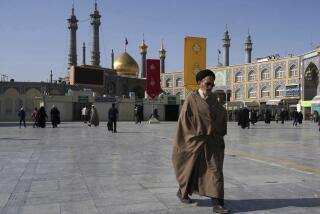Birth of Islamic Republics in Soviet Asia Envisioned : Unrest: Fundamentalists’ protest in Tadzhik capital is viewed by many as a clear sign of what is to come.
- Share via
DUSHANBE, Soviet Union — For the first time since glasnost liberated the millions of Muslims of Soviet Central Asia, Dushanbe’s main mosques were empty Friday. And for the first time that anyone here could recall, the city’s five Islamic priests canceled their sacred Friday prayers.
It was the latest round in Soviet Central Asia’s 70-year war between Islam and communism.
“We are asking that everyone just stay here on the square and pray to themselves,” said Abdugaffor Khodoidodov, the imam (leader) of the central mosque here in the capital of the Soviet republic of Tadzhikistan. “Because, at any moment, the Communist authorities might use force to clear (the area).
“It is written in the holy book, the Koran, that this cancellation of prayers is allowed in times of war or extreme peril,” the imam said. “And I would certainly call this a time of extreme peril.”
It is, indeed, not only for Khodoidodov but for all secular forces in Muslim-dominated Soviet Central Asia.
The continuing standoff here, pitting a hard-line Communist regime that took Tadzhikistan in a parliamentary coup Monday against protesters who have put up a city of red tents in Liberty Square, is not merely the Soviet Union’s most dramatic confrontation for now between fascism and freedom.
The almost medieval showdown in Liberty Square, where bearded protesters murmured their prayers from prayer rugs Friday and their leaders shouted “Death to the Communists!” could also chart the future of the four overwhelmingly Muslim republics of Soviet Central Asia.
To many analysts, the Muslim show of force at Liberty Square provides a clear sign of what is to come as the region’s more than 20 million Muslims shrug off 70 years of Communist rule and begin to assert their newfound religious and political power from thousands of mosques.
At stake is nothing less than the future religious map of all of Asia.
As Islamic fundamentalism begins to blossom again in these long-secular republics, many analysts see the development of an Islamic belt extending from North Africa to Bangladesh.
In the words of one Afghan intellectual who is a member of that country’s totalitarian but secular regime: “We see the formation now of an entire Islamic continent all around us, and I think that should be of concern to the whole world.”
Here in Soviet Central Asia, Communist regimes have clung to power in neighboring Uzbekistan and Turkmenistan largely by exploiting the fear of Islam among the region’s ethnic Russian minority, immigrants who still occupy key positions in the republics.
“Let us draw it as it could happen,” said Turdymurat Khodja Mukhammedov, the ultra-nationalist Turkmeni leader of the democracy movement in Turkmenistan’s capital of Ashkabad. “Islam surely will grow and grow fast. At the moment, we hope that Islam will never gain political power in Turkmenistan. Here, we hope it will be more like Turkey, where Islam and secular forces coexist.
“But in Tadzhikistan, Islam is very strong,” he continued. “It is the strongest of all of Central Asia. They have a party that is popular. And a lot of the future depends upon what happens in Dushanbe.”
Ethnic Russians and Jews began an exodus from Tadzhikistan after religious rioting in the capital city of Dushanbe left many dead in February, 1990. Together, these minorities represent just one-third of the city’s 680,000 residents, but they hold critical positions, such as doctors and technicians, in disproportionate numbers.
The emerging predominance of the Muslim Tadzhiks has accelerated sharply since this week’s pro-democracy eruption, with one local newspaper reporting that so many families are trying to move out of Dushanbe that the container-shipping terminal has a backlog lasting well into next year.
“We are beginning to feel completely trapped,” said one woman office worker with an ethnically mixed background who asked that her name not be used. “The majority of Tadzhiks, I think, really do want to have an Islamic republic here, but they’re using the call for democracy as a shield to get it.
“The problem, of course, is that everyone wants democracy,” she said. “So, the teachers and actors and war veterans are joining them on the square. But we’re all afraid that, no matter who wins the standoff, the forces for secularism will lose.”
It is precisely those fears that Tadzhikistan’s new hard-line president, Rakhman Nabiyev, is trying to exploit in its propaganda campaign to split the opposition and clear Liberty Square.
Nabiyev’s regime, clearly shaken by a pro-democracy press conference on Thursday that included the most powerful Islamic official in Tadzhikistan, Qazi Akhbar Turadzhonzoda, struck back Friday. Nabiyev summoned all local and foreign journalists to a bizarre news conference at his besieged Parliament building.
More than an hour before the session started, the regime played a heavily edited videotape of last weekend’s demonstration in Liberty Square, which climaxed Sunday morning when two, 40-ton cranes, attempting to remove the statue of Soviet founder V. I. Lenin, accidentally pulled him backward off his pedestal and sent him crashing head-first into the concrete, pulverizing his head.
The videotape then showed chanting imams leading this week’s protests, reading Islamic poetry and dancing over Lenin’s rubble. In a typical scene, the camera focused on a poster showing two hands burning a Communist Party membership card, and then panned down to a young boy holding a blue pocket Koran.
After the tape, the husky, silver-haired Nabiyev fought his way through a battery of largely hostile questions that helped define the new authoritarian leader as the classic nemesis of Central Asian Muslims.
One local journalist reminded Nabiyev, who had served as Tadzhikistan’s boss under conservative Soviet leader Leonid I. Brezhnev, that he was dismissed from his post in 1985 on charges of corruption and alcohol abuse. “When did you take your last drink of vodka, sir?” the reporter demanded. Nabiyev waved his hand and took the next question.
Nabiyev said several times that the protesters who continued to lay siege to his building were led not by the forces of democracy but by those of Islamic fundamentalism.
But he showed deep respect toward Turadzhonzoda, the most respected and popular religious leader in all of Tadzhikistan, whom the Communists have used for years to stem the tide of Islamic revivalism. “Yes,” he said, “I heard that (the Islamic leader) was at the opposition press conference yesterday, and I’m trying to find out why he was there.”
Turadzhonzoda had already answered that question the day before. It was time, he told the press, for Muslims to join forces with the city’s other democratic movements. “All of this turmoil here is all because everyone was brought up in communism and not in the mosques and the Islamic religious schools,” Turadzhonzoda said.
He readily conceded his long, close personal relationship with Nabiyev and other Communist leaders. “I’ve known Rahmon Nabiyev for a long time,” he said. “We are good friends. We have eaten a lot of bread and salt together.”
The Islamic leaders insisted time and again that they do not advocate officially proclaiming Tadzhikistan an Islamic republic. They maintained in separate interviews that Islam and democracy are compatible.
But on Liberty Square, it was unclear that they understood the full implications of democracy after seven decades of totalitarian rule.
For example, Imam Khodoidodov approved canceling Friday prayers only after a half-hour “interrogation of a prisoner” behind the Liberty Square’s makeshift stage.
“He was a provocateur,” the imam said. “We caught him trying to agitate people against our demonstration. He is a police detective on a secret mission to destroy us.” When asked how he knew, he replied: “Because he had no identification cards with him. In a state of emergency you must have these documents, so he must have been a spy.”
When asked whether Islam and democracy are compatible, the imam said: “Of course. I have been twice to the Islamic republic of Iran. I took part in the funeral of Ayatollah Khomeini. And I found that Iran is a democratic state in which everyone has the same rights.”
Asked whether Iran is a good model for a future democratic state of Tadzhikistan, the imam replied, “No, because the Muslims in Iran are Shiites and the Muslims in Tadzhikistan are Sunnis.
“We prefer China as our model.”
Reminded that China is also a Communist state, he added, “Compared to the U.S.S.R., China is a democracy.”
A few feet away, in the tent of hunger-striking religious leaders, the same question was asked of Turadzhon Kahorzada, the highest spiritual leader in Tadzhikistan of the large and mystical Sufi sect.
“I have been to Saudi Arabia for hajj (the holy pilgrimage to Mecca),” he said, running his fingers through his huge white beard as he sat on a bed of blankets and old rugs. “It is a country of freedom. The culture is developed. The shops are full of goods. There are no thieves anywhere. So I would prefer we become a country like Saudi Arabia.”
More to Read
Sign up for Essential California
The most important California stories and recommendations in your inbox every morning.
You may occasionally receive promotional content from the Los Angeles Times.













